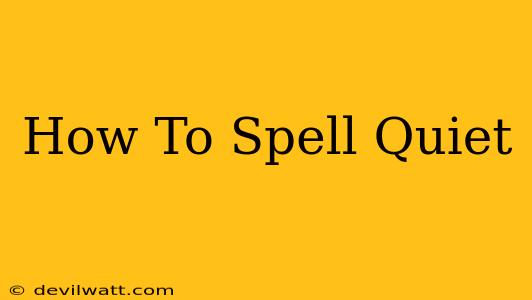Many people struggle with the spelling of "quiet." It's a deceptively simple word, but its unusual letter combination often trips up even seasoned spellers. This guide will help you conquer this spelling challenge once and for all!
Understanding the Spelling of "Quiet"
The word "quiet" presents a unique spelling challenge because it doesn't follow typical phonetic rules. Let's break it down:
- Q: Always followed by a U. This is a hard and fast rule in English spelling.
- UI: This combination makes a "kwai" sound. Think of the "kwai" sound in words like "quack" or "queen."
- E: This silent "e" is crucial! It's there to signal that the preceding vowel is long. Without the "e," the word would be pronounced differently.
- T: This is the final consonant, completing the word.
Common Misspellings of "Quiet"
Knowing the common mistakes helps you avoid them. Here are some typical misspellings:
- Quite: This is probably the most common misspelling, often confused due to similar pronunciation. Remember, "quite" means "to a significant extent," while "quiet" means "making little or no noise."
- Quiett: Adding an extra "t" is another frequent error. The word only has one "t."
- Quiete: This misspelling adds an extra "e," changing the pronunciation and meaning.
Tips and Tricks for Remembering How to Spell "Quiet"
Here are some memory aids to help you remember the correct spelling of "quiet":
- Mnemonic Devices: Create a memorable sentence or phrase using the word. For example: "Quietly Under Invisible Eyes Through the night." The more creative and personalized, the better!
- Visual Association: Imagine a picture in your mind that connects the letters with the meaning of the word. Maybe a quiet library or a hushed forest.
- Write it Repeatedly: The more you write the word, the more ingrained the spelling will become in your memory. Practice writing it in sentences.
- Use it in Context: Actively use the word in your writing and speaking. The more you utilize it, the more natural and familiar its spelling will become.
Distinguishing "Quiet" from "Quite"
The confusion between "quiet" and "quite" is understandable because they sound so similar. However, their meanings are completely different. Let's clarify:
- Quiet: Means making little or no noise; still; calm. Example: The library was very quiet.
- Quite: Means to a considerable extent; rather; fairly. Example: The movie was quite good.
Remember the subtle difference in meaning, and you'll be less likely to confuse the two words.
Conclusion: Mastering the Spelling of "Quiet"
Mastering the spelling of "quiet" takes practice and a bit of mnemonic strategy. By understanding the word's structure, recognizing common misspellings, and employing memory aids, you can confidently add this sometimes-tricky word to your spelling vocabulary. So, go ahead, write "quiet" correctly and conquer that spelling challenge!

